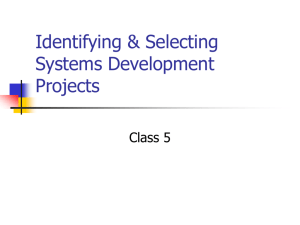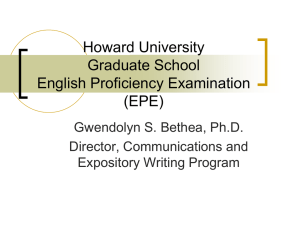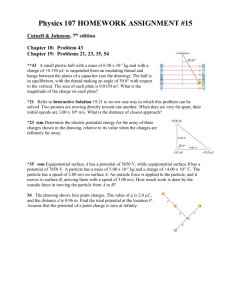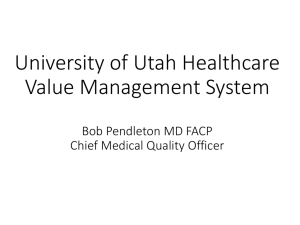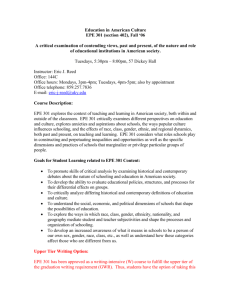Document
advertisement
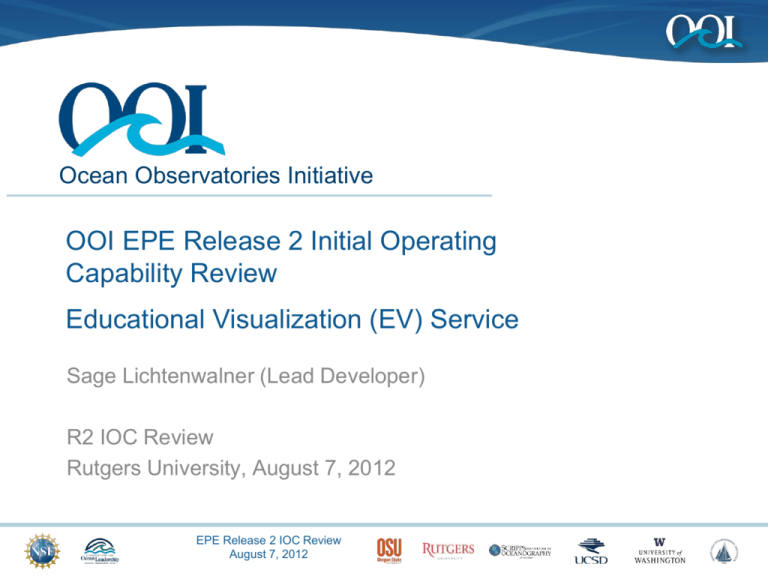
Ocean Observatories Initiative OOI EPE Release 2 Initial Operating Capability Review Educational Visualization (EV) Service Sage Lichtenwalner (Lead Developer) R2 IOC Review Rutgers University, August 7, 2012 EPE Release 2 IOC Review August 7, 2012 EV Code Development • SLOC • Changesets / Tool Versions 1 EPE Release 2 IOC Review August 7, 2012 EV Tool Design Specifications 2 EPE Release 2 IOC Review August 7, 2012 EV Use Cases 3 EPE Release 2 IOC Review August 7, 2012 EV Tool Verification 4 EPE Release 2 IOC Review August 7, 2012 EV Demos • Web Site • Tools 5 EPE Release 2 IOC Review August 7, 2012 EV Documentation • Inline help • Deployment instructions • Developer documentation and examples 6 EPE Release 2 IOC Review August 7, 2012 EV Usability Questions 7 EPE Release 2 IOC Review August 7, 2012 EV Philosophy 8 EPE Release 2 IOC Review August 7, 2012 9 EPE Release 2 IOC Review August 7, 2012 EPE Educational Visualization • Our Design Philosophy • Current Prototype Tools • Frameworks for using data in education EPE Release 2 IOC Review August 7, 2012 What is “Visualization”? Info Aesthetics Data Visualization Visual Analysis Information Design Visual Analytics Explorative Visualization Visualization Information Visualization (InfoVis) Bioinformatics Pragmatic Visualization Charting Cartography Graphing Infographics Data Art Mapping Scientific Illustration Information Art Infoporn Chart Junk Artistic Visualization “Visual analysis is not primarily about the pictures, but about finding ways to use our powerful visual systems to analyze data. It's analysis done in a visual way. It's visual exploration, visual data analysis, and visual presentation of results.” Robert Kosara, eagereyes.org EPE Release 2 IOC Review August 7, 2012 What Do Educators Want? NERRS Real-Time Data Needs Assessment 2006 COSEE NOW Educator Survey 2008 Top requested features: • Data visualization tools (ability to graph, map, chart data) • Inquiry-based lessons/activities • Lesson plans for teaching science concepts with RTD • Locally relevant data sets • Map interfaces • Stories or case studies that show how scientists use real-time data. Middle-school teachers were more likely to have students use: • Computers at school as part of their lessons • The Internet/websites at school as part of their lessons • Real-time data (mostly student-collected data) as part of their lessons EPE Release 2 IOC Review August 7, 2012 A Framework for Data Visualization Cognitive Levels of Different Audiences Raw Data Researchers Graduate Students Visualization Tools CDM HS / Undergrad Students Canned Images Data Complexity Public End Users Public Outreach Middle School Students Directed Inquiry Scientific Aptitude EPE Release 2 IOC Review August 7, 2012 Policy Makers Guided Inquiry Full Inquiry EPE Design Philosophy EPE Visualization Tools are designed to be: • • Customizable – Adapt them to fit your learning goals Embeddable – Place them in context within your lessons 14 EPE Release 2 IOC Review August 7, 2012 15 EPE Release 2 IOC Review August 7, 2012 EPE Design Philosophy EPE Visualization Tools are designed to be: • • • • Customizable – Adapt them to fit your learning goals Embeddable – Place them in context within your lessons Focused – Learning outcome driven not data driven (I.e. these are not your typical comprehensive tool) Simple – Intuitive & easy to use 16 EPE Release 2 IOC Review August 7, 2012 A Scientist’s Glider Visualization Tool Audience Needs: Raw data, Advanced viz & processing tools Challenges: Storage, Processing power, Metadata, Flexibility EPE Release 2 IOC Review August 7, 2012 And Educator’s Visualization Tool Driving Questions: This tool will allow students to analyze single glider profiles (also called casts) to investigate the following questions: • How do measurements vary over the depth of the water column? • How does the shape of a particular measurement's profile vary over time and/or location? EPE Release 2 IOC Review August 7, 2012 EPE Design Philosophy EPE Visualization Tools are designed to be: • • • • • Customizable – Adapt them to fit your learning goals Embeddable – Place them in context within your lessons Focused – Learning outcome driven not data driven (I.e. these are not your typical comprehensive tool) Simple – Intuitive & easy to use Educational – Primary goal is to aid analysis and understanding of scientific processes, not dealing with data formats and graphing 19 EPE Release 2 IOC Review August 7, 2012 Data lesson: Find your water mass Students use two different properties measured by Slocum gliders to find a water mass with a particular “fingerprint”. Ross Sea, Antarctica “fingerprint:” Temperature = 1.3°C Oxygen concentration = 6.5ml/L Students are guided through the process: 1) Identify where each “fingerprint” property is on the associated data visualization. 2) Identify where the two properties overlap (200-300m depth, ~600km along segment distance). 3) Use the map of the glider track (not shown) to find the latitude and longitude of that point along the segment. EPE Release 2 IOC Review August 7, 2012 LSC: Lessons Learned Most students are lacking data skills: • Data orientation (using titles, axes, scales, labels) • Identifying trends • Map reading; latitude and longitude • Including units Strategies: • Model data orientation skills • Break analysis into steps • Clearly label/bold relevant information • Simplify data to make trends stand out Version 1: raw glider data Students had difficulty • -choosing the correct color from the scale • -outlining the appropriate color on the data plot. EPE Release 2 IOC Review August 7, 2012 Version 2: simplified data • • Reduced number of shades on the color scale -Cearly defined boundaries between shades, for both scale bar and data plot PROTOTYPES 22 EPE Release 2 IOC Review August 7, 2012 Visualization Tool #1 23 EPE Release 2 IOC Review August 7, 2012 Visualization Tool #2 24 EPE Release 2 IOC Review August 7, 2012 Visualization Tool #4 25 EPE Release 2 IOC Review August 7, 2012 Visualization Tool #5 26 EPE Release 2 IOC Review August 7, 2012 Visualization Design Theory Ben Fry’s seven stages of visualizing data: • Acquire • Parse • Filter • Mine • Represent • Refine • Interact EPE Release 2 IOC Review August 7, 2012 Learning Sciences Theory Visualization for Learners Inquiry-based learning units must include: • Motivating context • Learner-appropriate activities • Appropriate datasets • Scaffolding interfaces • Support for learning (Edelson & Gordin 1998) Learning-for-Use • Motivation – Experience demand – Experience curiosity • Knowledge Construction – Observe – Receive communication • Knowledge Refinement – Apply – Reflect (Edelson 2001) EPE Release 2 IOC Review August 7, 2012 Are we stuck on the left? EPE Release 2 IOC Review August 7, 2012 http://flowingdata.com/2010/09/21/human-centric-analysis/ Examples High Adventure Science Concord Consortium iBooks Author Apple 30 EPE Release 2 IOC Review August 7, 2012 Interactive Glider Profile Tool 31 EPE Release 2 IOC Review August 7, 2012 Educational Visualization Service Capabilities • Provides a collection of interactive visualization tools to explore and analyze OOI Datasets • R2: Focus on profile and time series tools • Allows users to save customize tools (called “custom instances”) • R2: Beta version of this functionality • Allows users to embed custom instances on third-party web pages • R2: Test capability. Implement in R3 • Provides a library of visualizations • R2: List only, search and categorization in R3 32 EPE Release 2 IOC Review August 7, 2012 Educational Visualization in R2 Architecture and Technologies Data Layer Service Layer Client Layer • Science Data • CI and EPE Web Services • Visualization Tool Scripts • file system • Customized Visualization Tool Data • MySQL • Web Interface • Prototyped in CakePHP • Eventually envisioned as a Drupal module • Web browser based visualization tools • D3.js (JavaScript) • Google Maps/ OpenLayers API Components 1. Tool Management (index, create, edit, delete) 2. Instance Management (personal index, create, view, edit options, edit metadata, publish, delete, copy) 3. Instance Builder 4. Instance Directory (index, search, filter) 5. Instance View (view, embed) 6. Glider Tools (profile, map, transect) 7. Mooring Tools (time series) d3 demo 33 EPE Release 2 IOC Review August 7, 2012 Educational Visualization in R2 Initial Content Model 34 EPE Release 2 IOC Review August 7, 2012
